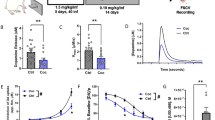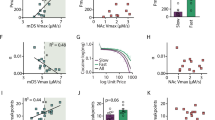Abstract
Agonist-replacement therapies have been successfully used for treatment of opiate and nicotine addiction, but not for cocaine addiction. One of the major obstacles is the cocaine-like addictive potential of the agonists themselves. We report here an atypical dopamine (DA) transporter (DAT) inhibitor, CTDP-32476, that may have translational potential for treating cocaine addiction. In vitro ligand-binding assays suggest that CTDP-32476 is a potent and selective DAT inhibitor and a competitive inhibitor of cocaine binding to the DAT. Systemic administration of CTDP-32476 alone produced a slow-onset, long-lasting increase in extracellular nucleus accumbens DA, locomotion, and brain-stimulation reward. Drug-naive rats did not self-administer CTDP-32476. In a substitution test, cocaine self-administration rats displayed a progressive reduction in CTDP-32476 self-administration with an extinction pattern of drug-taking behavior, suggesting significantly lower addictive potential than cocaine. Pretreatment with CTDP-32476 inhibited cocaine self-administration, cocaine-associated cue-induced relapse to drug seeking, and cocaine-enhanced extracellular DA in the nucleus accumbens. These findings suggest that CTDP-32476 is a unique DAT inhibitor that not only could satisfy ‘drug hunger’ through its slow-onset long-lasting DAT inhibitor action, but also render subsequent administration of cocaine ineffectual—thus constituting a novel and unique compound with translational potential as an agonist therapy for treatment of cocaine addiction.
Similar content being viewed by others
Log in or create a free account to read this content
Gain free access to this article, as well as selected content from this journal and more on nature.com
or
References
Allouche S, Noble F, Marie N (2014). Opioid receptor desensitization: mechanisms and its link to tolerance. Front Pharmacol 5: 280.
Amato L, Davoli M, Perucci C, Ferri M, Faggiano F, Mattick RP (2005). An overview of systematic reviews of the effectiveness of opioid maintenance therapies: available evidence to inform clinical practice and research. J Subst Abuse Treat 28: 321–329.
Baumann MH, Char GU, De Costa BR, Rice KC, Rothman RB (1994). GBR12909 attenuates cocaine-induced activation of mesolimbic dopamine neurons in the rat. J Pharmacol Exp Ther 271: 1216–1222.
Budygin EA, Kilpatrick MR, Gainetdinov RR, Wightman RM (2000). Correlation between behavior and extracellular dopamine levels in rat striatum: comparison of microdialysis and fast-scan cyclic voltammetry. Neurosci Lett 281: 9–12.
Busto U, Sellers EM (1986). Pharmacokinetic determinants of drug abuse and dependence. A conceptual perspective. Clin Pharmacokinet 11: 144–153.
Carroll FI, Howard JL, Howell LL, Fox BS, Kuhar MJ (2006). Development of the dopamine transporter selective RTI-336 as a pharmacotherapy for cocaine abuse. Aaps J 8: E196–E203.
Cheng YC, Prusoff WH (1973). Relationship between the inhibition constant (KI) and the concentration of inhibitor which causes 50 per cent inhibition (I50) of an enzymatic reaction. Biochem Pharmacol 22: 3099–3108.
Espana RA, Roberts DC, Jones SR (2008). Short-acting cocaine and long-acting GBR-12909 both elicit rapid dopamine uptake inhibition following intravenous delivery. Neuroscience 155: 250–257.
Everitt BJ, Belin D, Economidou D, Pelloux Y, Dalley JW, Robbins TW (2008). Review. Neural mechanisms underlying the vulnerability to develop compulsive drug-seeking habits and addiction. Philos Trans R Soc Lond B Biol Sci 363: 3125–3135.
Froimowitz M, Gu Y, Dakin LA, Nagafuji PM, Kelley CJ, Parrish D et al (2007). Slow-onset, long-duration, alkyl analogues of methylphenidate with enhanced selectivity for the dopamine transporter. J Med Chem 50: 219–232.
Froimowitz M, Wu K-M, Moussa A, Haidar RM, Jurayj J, George C et al (2000). Slow-onset, long-duration 3-(3‘,4‘-dichlorophenyl)-1-indanamine monoamine reuptake blockers as potential medications to treat cocaine abuse. J Med Chem 43: 4981–4992.
Gardner EL, Liu X, Paredes W, Giordano A, Spector J, Lepore M et al (2006). A slow-onset, long-duration indanamine monoamine reuptake inhibitor as a potential maintenance pharmacotherapy for psychostimulant abuse: effects in laboratory rat models relating to addiction. Neuropharmacology 51: 993–1003.
Gerra G, Maremmani I, Capovani B, Somaini L, Berterame S, Tomas-Rossello J et al (2009). Long-acting opioid-agonists in the treatment of heroin addiction: why should we call them "substitution"? Subst Use Misuse 44: 663–671.
Glowa JR, Fantegrossi WE, Lewis DB, Matecka D, Rice KC, Rothman RB (1996). Sustained decrease in cocaine-maintained responding in rhesus monkeys with 1-[2-[bis(4-fluorophenyl)methoxy]ethyl]-4-(3-hydroxy-3-phenylpropyl) piperazinyl decanoate, a long-acting ester derivative of GBR 12909. J Med Chem 39: 4689–4691.
Gorelick DA, Gardner EL, Xi ZX (2004). Agents in development for the management of cocaine abuse. Drugs 64: 1547–1573.
Grabowski J, Shearer J, Merrill J, Negus SS (2004). Agonist-like, replacement pharmacotherapy for stimulant abuse and dependence. Addict Behav 29: 1439–1464.
Howell LL, Wilcox KM (2001). The dopamine transporter and cocaine medication development: drug self-administration in nonhuman primates. J Pharmacol Exp Ther 298: 1–6.
Jin Z-L, Gao N, Zhou D, Chi M-G, Yang X-M, Xu J-P (2012). The extracts of Fructus Akebiae, a preparation containing 90% of the active ingredient hederagenin: serotonin, norepinephrine and dopamine reuptake inhibitor. Pharmacol Biochem Behav 100: 431–439.
Kalivas PW, Volkow ND (2005). The neural basis of addiction: a pathology of motivation and choice. Am J Psychiatry 162: 1403–1413.
Kimmel HL, Negus SS, Wilcox KM, Ewing SB, Stehouwer J, Goodman MM et al (2008). Relationship between rate of drug uptake in brain and behavioral pharmacology of monoamine transporter inhibitors in rhesus monkeys. Pharmacol Biochem Behav 90: 453–462.
Kimmel HL, O'Connor JA, Carroll FI, Howell LL (2007). Faster onset and dopamine transporter selectivity predict stimulant and reinforcing effects of cocaine analogs in squirrel monkeys. Pharmacol Biochem Behav 86: 45–54.
Koob GF, Ahmed SH, Boutrel B, Chen SA, Kenny PJ, Markou A et al (2004). Neurobiological mechanisms in the transition from drug use to drug dependence. Neurosci Biobehav Rev 27: 739–749.
Kuhar MJ, Pilotte NS (1996). Neurochemical changes in cocaine withdrawal. Trends Pharmacol Sci 17: 260–264.
Li SM, Kopajtic TA, O'Callaghan MJ, Agoston GE, Cao J, Newman AH et al (2011). N-substituted benztropine analogs: selective dopamine transporter ligands with a fast onset of action and minimal cocaine-like behavioral effects. J Pharmacol Exp Ther 336: 575–585.
Li X, Li J, Gardner EL, Xi ZX (2010). Activation of mGluR7s inhibits cocaine-induced reinstatement of drug-seeking behavior by a nucleus accumbens glutamate-mGluR2/3 mechanism in rats. J Neurochem 114: 1368–1380.
Loland CJ, Desai RI, Zou MF, Cao J, Grundt P, Gerstbrein K et al (2008). Relationship between conformational changes in the dopamine transporter and cocaine-like subjective effects of uptake inhibitors. Mol Pharmacol 73: 813–823.
Mattick RP, Breen C, Kimber J, Davoli M (2009). Methadone maintenance therapy versus no opioid replacement therapy for opioid dependence. Cochrane Database Syst Rev 2009 (3): CD002209.
Nader MA, Grant KA, Davies HM, Mach RH, Childers SR (1997). The reinforcing and discriminative stimulus effects of the novel cocaine analog 2beta-propanoyl-3beta-(4-tolyl)-tropane in rhesus monkeys. J Pharmacol Exp Ther 280: 541–550.
Nakachi N, Kiuchi Y, Inagaki M, Inazu M, Yamazaki Y, Oguchi K (1995). Effects of various dopamine uptake inhibitors on striatal extracellular dopamine levels and behaviours in rats. Eur J Pharmacol 281: 195–203.
Negus SS, Mello NK, Kimmel HL, Howell LL, Carroll FI (2009). Effects of the monoamine uptake inhibitors RTI-112 and RTI-113 on cocaine- and food-maintained responding in rhesus monkeys. Pharmacol Biochem Behav 91: 333–338.
Newman AH, Kulkarni S (2002). Probes for the dopamine transporter: new leads toward a cocaine-abuse therapeutic—a focus on analogues of benztropine and rimcazole. Med Res Rev 22: 429–464.
Oldendorf WH (1992). Some relationships between addiction and drug delivery to the brain. NIDA Res Monogr 120: 13–25.
Peng X-Q, Xi Z-X, Li X, Spiller K, Li J, Chun L et al (2010). Is slow-onset long-acting monoamine transport blockade to cocaine as methadone is to heroin? implication for anti-addiction medications. Neuropsychopharmacology 35: 2564–2578.
Platt DM, Rowlett JK, Spealman RD (2002). Behavioral effects of cocaine and dopaminergic strategies for preclinical medication development. Psychopharmacology 163: 265–282.
Reavill C, Boyfield I, Coldwell M, Nelson P (2000). Comparative pharmacological study of ropinirole (SKF-101468) and its metabolites in rats. J Pharmacy Pharmacol 52: 1129–1135.
Reith ME, Blough BE, Hong WC, Jones KT, Schmitt KC, Baumann MH et al (2015). Behavioral, biological, and chemical perspectives on atypical agents targeting the dopamine transporter. Drug Alcohol Depend 147: 1–19.
Reith ME, Xu C, Carroll FI, Chen NH (1998). Inhibition of [3H]dopamine translocation and [3H]cocaine analog binding: a potential screening device for cocaine antagonists. Methods Enzymol 296: 248–259.
Richardson NR, Roberts DCS (1996). Progressive ratio schedules in drug self-administration studies in rats: a method to evaluate reinforcing efficacy. J Neurosci Methods 66: 1–11.
Rothman RB, Baumann MH, Prisinzano TE, Newman AH (2008). Dopamine transport inhibitors based on GBR12909 and benztropine as potential medications to treat cocaine addiction. Biochem Pharmacol 75: 2–16.
Runyon SP, Carroll FI (2006). Dopamine transporter ligands: recent developments and therapeutic potential. Curr Top Med Chem 6: 1825–1843.
Samaha AN, Robinson TE (2005). Why does the rapid delivery of drugs to the brain promote addiction? Trends Pharmacol Sci 26: 82–87.
Silagy C, Lancaster T, Stead L, Mant D, Fowler G (2004). Nicotine replacement therapy for smoking cessation. Cochrane Database Syst Rev 2004 (3): CD000146.
Stead LF, Perera R, Bullen C, Mant D, Hartmann-Boyce J, Cahill K et al (2012). Nicotine replacement therapy for smoking cessation. Cochrane Database Syst Rev 2012 (11): CD000146.
Tanda G, Newman AH, Ebbs AL, Tronci V, Green JL, Tallarida RJ et al (2009). Combinations of cocaine with other dopamine uptake inhibitors: assessment of additivity. J Pharmacol Exp Ther 330: 802–809.
Vocci F, Ling W (2005). Medications development: successes and challenges. Pharmacol Ther 108: 94–108.
Volkow ND, Fowler JS, Wang GJ, Ding YS, Gatley SJ (2002). Role of dopamine in the therapeutic and reinforcing effects of methylphenidate in humans: results from imaging studies. Eur Neuropsychopharmacol 12: 557–566.
Volkow ND, Wang GJ, Fischman MW, Foltin R, Fowler JS, Franceschi D et al (2000). Effects of route of administration on cocaine induced dopamine transporter blockade in the human brain. Life Sci 67: 1507–1515.
Wakabayashi KT, Weiss MJ, Pickup KN, Robinson TE (2010). Rats markedly escalate their intake and show a persistent susceptibility to reinstatement only when cocaine is injected rapidly. J Neurosci 30: 11346–11355.
Wise RA (1996). Neurobiology of addiction. Curr Opin Neurobiol 6: 243–251.
Xi ZX, Gardner EL (2008). Hypothesis-driven medication discovery for the treatment of psychostimulant addiction. Curr Drug Abuse Rev 1: 303–327.
Xi ZX, Spiller K, Pak AC, Gilbert J, Dillon C, Li X et al (2008). Cannabinoid CB1 receptor antagonists attenuate cocaine's rewarding effects: experiments with self-administration and brain-stimulation reward in rats. Neuropsychopharmacology 33: 1735–1745.
Author information
Authors and Affiliations
Corresponding author
Rights and permissions
About this article
Cite this article
Xi, ZX., Song, R., Li, X. et al. CTDP-32476: A Promising Agonist Therapy for Treatment of Cocaine Addiction. Neuropsychopharmacol 42, 682–694 (2017). https://doi.org/10.1038/npp.2016.155
Received:
Revised:
Accepted:
Published:
Issue date:
DOI: https://doi.org/10.1038/npp.2016.155
This article is cited by
-
RDS-04-010: a novel atypical DAT inhibitor that inhibits cocaine taking and seeking and itself has low abuse potential in experimental animals
Translational Psychiatry (2025)
-
AM6527, a neutral CB1 receptor antagonist, suppresses opioid taking and seeking, as well as cocaine seeking in rodents without aversive effects
Neuropsychopharmacology (2024)
-
Translating the atypical dopamine uptake inhibitor hypothesis toward therapeutics for treatment of psychostimulant use disorders
Neuropsychopharmacology (2019)
-
The Novel Modafinil Analog, JJC8-016, as a Potential Cocaine Abuse Pharmacotherapeutic
Neuropsychopharmacology (2017)



